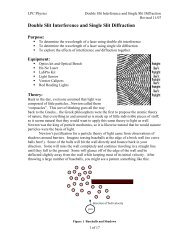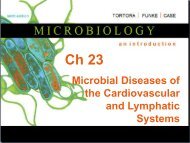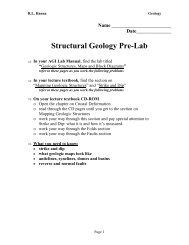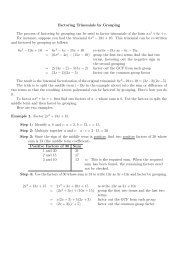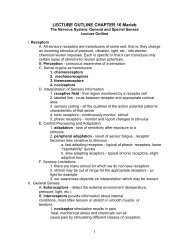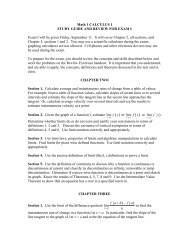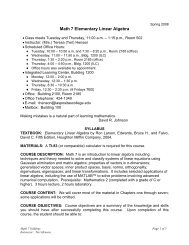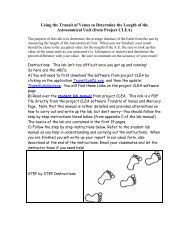Microbial Diseases of the Nervous System
Microbial Diseases of the Nervous System
Microbial Diseases of the Nervous System
Create successful ePaper yourself
Turn your PDF publications into a flip-book with our unique Google optimized e-Paper software.
Ch 22<br />
<strong>Microbial</strong><br />
<strong>Diseases</strong> <strong>of</strong><br />
<strong>the</strong> <strong>Nervous</strong><br />
<strong>System</strong>
Student Learning Outcomes<br />
Review anatomy <strong>of</strong> CNS, PNS, meninges, BBB<br />
Differentiate meningitis from encephalitis including diagnosis and<br />
treatment.<br />
Discuss mode <strong>of</strong> transmission, etiology, disease symptoms,<br />
treatment, and preventive measures <strong>of</strong><br />
• Bacterial meningitis caused by H. influenzae, S. pneumoniae, N.<br />
meningitidis, and L. monocytogenes<br />
• Tetanus<br />
• Botulism<br />
• Leprosy<br />
• Rabies<br />
• Arboviral encephalitis,<br />
• Cryptococcosis.<br />
• African trypanosomiasis<br />
• Prion diseases<br />
Compare and contrast <strong>the</strong> Salk and Sabin vaccines<br />
Copyright © 2010 Pearson Education, Inc.
Anatomy and Physiology Review<br />
Fig 22.1<br />
How do microbes enter <strong>the</strong><br />
CNS ?<br />
Copyright © 2010 Pearson Education, Inc.<br />
Fig 22.2
The Meninges and Cerebrospinal Fluid<br />
Fig 22.2<br />
Copyright © 2010 Pearson Education, Inc.
Bacterial <strong>Diseases</strong> <strong>of</strong> <strong>the</strong> CNS<br />
Bacteria can grow in CSF in subarachnoid<br />
space.<br />
The BBB prevents passage <strong>of</strong> some materials<br />
(such as antimicrobial drugs) into CNS.<br />
Meningitis vs. encephalitis<br />
Meningitis can be caused by viruses, bacteria,<br />
fungi, and protozoa.<br />
BACTERIAL MENINGITIS: Much more serious<br />
than viral. Can cause severe disease resulting<br />
in brain damage and death.<br />
Copyright © 2010 Pearson Education, Inc.
Bacterial Meningitis<br />
• The three major causes:<br />
• Haemophilus influenzae<br />
• Neisseria meningitidis<br />
• S. pneumoniae<br />
• Nearly 50 species <strong>of</strong> opportunistic bacteria can<br />
cause meningitis (L. monocytogenes, S. pyogenes,<br />
S. aureus)<br />
• Symptoms: Fever, headache, stiff neck, followed by<br />
nausea and vomiting may progress to<br />
convulsions, coma, shock, and death<br />
• Diagnosis by Gram stain or latex agglutination <strong>of</strong><br />
CSF<br />
• Copyright Cephalosporins © 2010 Pearson Education, Inc. before identification <strong>of</strong> pathogen!
Epidemiology <strong>of</strong> Bacterial Meningitis<br />
Not very contagious spreads by direct close<br />
contact with discharges from nose/throat <strong>of</strong> infected<br />
person.<br />
Vaccines:<br />
1988: Hib<br />
2000: PCV7<br />
(Prevnar®) new for use<br />
in children < 2 y old.<br />
2005: MCV4<br />
(MenactraT®) vaccine <strong>of</strong><br />
choice for 11 to 55 y old<br />
(old vaccine since 1982)<br />
Copyright © 2010 Pearson Education, Inc.<br />
Fig 22.3
Spinal Tap (Lumbar Puncture)<br />
Copyright © 2010 Pearson Education, Inc.<br />
Fig 22.4
Haemophilus influenzae Meningitis (Hib)<br />
• Gram-negative,<br />
pleomorphic<br />
coccobacilli,<br />
capsule<br />
• Common part <strong>of</strong><br />
normal throat<br />
microbiota<br />
• Fastidious needs factors in blood (genus<br />
name!). Species name is misnomer.<br />
• Mostly in children under age 4 (especially around<br />
6 month <strong>of</strong> age. Why?)<br />
• Also causes pneumonia, otitis media, epiglottitis<br />
Copyright © 2010 Pearson Education, Inc.
Neisseria Meningitis: Meningococcal<br />
Meningitis<br />
Gram-neg cocci,<br />
capsule<br />
~ 10% <strong>of</strong> people are<br />
healthy nasopharyngeal<br />
carriers<br />
Begins as throat<br />
infection, typical rash death may occur within a<br />
few hours <strong>of</strong> onset.<br />
Continuing threat in day-care centers and schools.<br />
Mostly in children < 2 y <strong>of</strong> age.<br />
Sporadic outbreaks among young adults.<br />
Copyright Vaccination © 2010 Pearson Education, Inc. recommended for college students
Meningococcal Rash<br />
About half <strong>the</strong> children or adults with meningococcal<br />
meningitis have rash that does not fade<br />
Exotoxins<br />
damage blood<br />
vessel walls <br />
blood leaks into<br />
skin<br />
Copyright © 2010 Pearson Education, Inc.<br />
Glass test, or pressure test –<br />
septicaemic rash usually does not<br />
fade under pressure. (Not 100%<br />
reliable.)
Pneumococcal Meningitis – S.<br />
pneumoniae<br />
• Gram-positive diplococci<br />
• Typically associated with<br />
pneumonia, but may cause<br />
pneumococcal meningitis and<br />
pneumococcal septicemia.<br />
• 70% <strong>of</strong> people are healthy nasopharyngeal<br />
carriers<br />
• Most common in children (1 month to 4<br />
years)<br />
• Mortality: 30% in children, 80% in elderly<br />
Copyright © 2010 Pearson Education, Inc.
Listeriosis<br />
• Listeria monocytogenes<br />
• Gram-positive<br />
• Reproduce in<br />
phagocytes.<br />
Fig 22.5<br />
• Acquired by ingestion <strong>of</strong> contaminated food -<br />
psychrophil!<br />
• May be asymptomatic in healthy adults.<br />
• Causes meningitis in newborns, immunosuppressed,<br />
pregnant women, and cancer patients.<br />
• Can cross placenta and cause spontaneous abortion<br />
and stillbirth<br />
Copyright © 2010 Pearson Education, Inc.
<strong>Diseases</strong> in Focus:<br />
Meningitis and Encephalitis<br />
Copyright © 2010 Pearson Education, Inc.<br />
• A worker in a day-care<br />
center in eastern North<br />
Dakota became ill with<br />
fever, rash, headache, and<br />
abdominal pain. The<br />
patient had a precipitous<br />
clinical decline and died on<br />
<strong>the</strong> first day <strong>of</strong><br />
hospitalization. Diagnosis<br />
was confirmed by Gram<br />
staining <strong>of</strong> cerebrospinal<br />
fluid.<br />
• Can you identify infections<br />
that could cause <strong>the</strong>se<br />
symptoms?
Tetanus (Lockjaw)<br />
• Clostridium tetani<br />
• Gram-positive, endospore-forming, obligate<br />
anaerobe<br />
• Grows in deep wounds.<br />
• Tetanospasmin (exotoxin / neurotoxin)<br />
released from dead cells blocks relaxation<br />
pathway in muscles. Tetanospasmin action.<br />
• Prevention by vaccination with tetanus toxoid<br />
(DTaP) and booster (dT).<br />
• Treatment with tetanus immune globulin.<br />
Copyright © 2010 Pearson Education, Inc.
Tetanospasmin Action<br />
Blockage <strong>of</strong><br />
inhibitory NT release<br />
in CNS (glycine and<br />
GABA – gammaanimobutyric<br />
acid)<br />
Result ?<br />
Copyright © 2010 Pearson Education, Inc.
Why characteristic<br />
backward arc?<br />
Characteristic<br />
condition:<br />
Opistothonos<br />
90% fatality rate<br />
Copyright © 2010 Pearson Education, Inc.<br />
Neonatal tetanus with severe muscle<br />
contractions.<br />
-courtesy <strong>of</strong> CDC-
Botulism<br />
• Clostridium botulinum<br />
• Gram-positive, endospore-forming, obligate<br />
anaerobe, ubiquitous in soil and H 2 O<br />
• Intoxication (ingestion <strong>of</strong> botulinum toxin): 7<br />
different Neurotoxins (exotoxins, A, B and E cause<br />
most human illness)<br />
• Type A<br />
• 60-70% fatality<br />
• Found in CA, WA, CO, OR, NM.<br />
• Type B<br />
• 25% fatality<br />
• Europe and eastern United States<br />
• Type E<br />
Copyright © 2010 Pearson Education, Inc.
Botulinum Toxin: Most Potent Toxin on Earth<br />
• Mechanism <strong>of</strong> action: Irreversible<br />
inhibition <strong>of</strong> ACh release from motor neuron<br />
________<br />
• Treatment: ?<br />
• Prevention<br />
• Proper canning<br />
• Nitrites prevent endospore germination in<br />
sausages<br />
Copyright © 2010 Pearson Education, Inc.
3 Forms <strong>of</strong> Botulism<br />
1. Foodborne botulism: Intoxication not<br />
infection! Endospores survive improper<br />
canning procedures.<br />
2. Wound botulism: ~ symptoms as<br />
above, start ~ 4 days after wound<br />
infection<br />
3. Infant botulism: due to ingestion<br />
<strong>of</strong> endospores C. botulinum<br />
growing in intestines.<br />
In animals: limberneck<br />
Copyright © 2010 Pearson Education, Inc.
Botulinum Toxin: Killer and Healer<br />
Botox (Botulinum toxin type A)<br />
Medical uses: blephrospasms,<br />
strabismus, torticollis . . . . . etc.<br />
Under investigation: migraine<br />
headaches, hyperhidrosis<br />
Cosmetic purposes<br />
Copyright © 2010 Pearson Education, Inc.
Spastic<br />
torticollis:<br />
neck in a<br />
twisted or<br />
bent position<br />
Blepharospasm is a focal<br />
dystonia characterized by<br />
increased blinking and<br />
involuntary closing <strong>of</strong> <strong>the</strong> eyes.<br />
Copyright © 2010 Pearson Education, Inc.
Leprosy or Hansen’s Disease<br />
Copyright © 2010 Pearson Education, Inc.
• Mycobacterium leprae (acid-fast rod)<br />
• Grows best at 30°C cooler body regions<br />
(peripheral nerves and skin cells)<br />
• Transmission requires prolonged contact with an<br />
infected person. Mostly via nasal secretions <strong>of</strong><br />
lepromatous leprosy patients<br />
Incubation time: Months to 10 years<br />
Two forms depending on immune response<br />
1. Tuberculoid (neural) form: Loss <strong>of</strong> sensation in<br />
skin areas; positive lepromin test<br />
2. Lepromatous (progressive) form: in case <strong>of</strong> cell<br />
mediated IS failure) Disfiguring nodules over body;<br />
negative lepromin test<br />
Copyright © 2010 Pearson Education, Inc.
Tuberculoid leprosy in a 24-year-old Samoan woman with sevenmonth<br />
history <strong>of</strong> expanding plaque on cheek. Note <strong>the</strong> thickened<br />
accessory Copyright © 2010 Pearson nerve Education, Inc. coursing over <strong>the</strong> sternomastoid muscle.
Copyright © 2010 Pearson Education, Inc.<br />
Patient with active,<br />
neglected nodulous<br />
lepromatous<br />
leprosy. With<br />
treatment, all<br />
nodules could be<br />
reversed.<br />
©WHO/TDR/McDou<br />
gall
Azadegan Clinic,<br />
Teheran: The foot <strong>of</strong><br />
a woman that has<br />
been grossly<br />
disfigured through<br />
leprosy infection. ©<br />
World Health<br />
Organization/TDR/C<br />
rump<br />
Deformity due to nerve damage with its consequent ulcers and<br />
resorption <strong>of</strong> bone. Such deformities can be worsened by careless<br />
use Copyright <strong>of</strong> © 2010 <strong>the</strong> Pearson hands. Education, Inc. © WHO/TDR
Viral <strong>Diseases</strong> <strong>of</strong> <strong>the</strong> <strong>Nervous</strong> <strong>System</strong><br />
VIRAL MENINGITIS:<br />
Usually mild. Clears up<br />
within a week or two<br />
without specific<br />
treatment. Also called<br />
aseptic meningitis.<br />
Poliomyelitis<br />
Rabies<br />
Viral meningitis<br />
Viral encephalitis<br />
Copyright © 2010 Pearson Education, Inc.
Poliomyelitis – Infantile Paralysis<br />
Poliovirus (Enteroviruses <strong>of</strong> picornaviridae)<br />
Transmitted by ingestion. 3 strains <strong>of</strong> polio virus<br />
(1,2,3)<br />
90% <strong>of</strong> cases asymptomatic<br />
Initial symptoms: Sore throat and nausea<br />
Viremia may occur; if persistent, virus can enter <strong>the</strong><br />
CNS; Selective destruction <strong>of</strong> motor neurons and<br />
paralysis occurs in
Worldwide Annual Incidence <strong>of</strong><br />
Poliomyelitis<br />
Copyright © 2010 Pearson Education, Inc.<br />
Fig 22.11
Prevention and Treatment<br />
FDR, President from<br />
1932 to 1945<br />
Copyright © 2010 Pearson Education, Inc.<br />
• 1955: Salk vaccine<br />
(Inactivated – IPV)<br />
• 1961: Sabine vaccine<br />
(Live, attenuated, oral –<br />
OPV). Advantages ?<br />
• OPV has caused all <strong>the</strong><br />
polio cases in <strong>the</strong> US<br />
between 1980 and 1999<br />
• 2000: CDC recommends<br />
new IPV (E_IPV) for<br />
routine immunization
Rabies Virus (<strong>of</strong> Rhabdoviridae)<br />
• Zoonosis – Transmission from saliva <strong>of</strong> rabid animal<br />
• Virus multiplies in skeletal muscles, <strong>the</strong>n retrograde<br />
axonal transport to CNS (encephalitis), <strong>the</strong>n back out<br />
to periphery (salivary glands etc.)<br />
• Initial symptoms may include muscle spasms <strong>of</strong> <strong>the</strong><br />
mouth and pharynx and hydrophobia.<br />
• Furious rabies: Animals<br />
restless <strong>the</strong>n highly<br />
excitable.<br />
• Paralytic rabies: Animals<br />
unaware <strong>of</strong> surroundings.<br />
Copyright © 2010 Pearson Education, Inc.
Pathology <strong>of</strong> Rabies Infection<br />
Fig 22.12
Treatment and Prevention<br />
• Highly fatal – only handful <strong>of</strong> people survived<br />
• Preexposure prophylaxis: Human diploid cells<br />
vaccine (HDCV) applied i.m.<br />
• Postexposure prophylaxis (PEP):<br />
• Vaccine (HDCV, applied i.m. on days 0, 3, 7, 14,<br />
and 28)<br />
• Human rabies immune globulin (RIG)<br />
• Rodents and rabbits seldom get rabies. Dogs,<br />
cats, cattle, skunks, raccoons, bats, etc. do <br />
Vaccination <strong>of</strong> pets! If necessary vaccination <strong>of</strong><br />
wild populations<br />
Copyright © 2010 Pearson Education, Inc.
genetically engineered,<br />
vaccinia-rabies<br />
glycoprotein (V-RG) virus<br />
has proven to be orally<br />
effective in raccoons.<br />
ORV<br />
Copyright © 2010 Pearson Education, Inc.<br />
CDC rabies prevention
Reported Cases <strong>of</strong> Rabies in Animals<br />
Fig 22.13<br />
Copyright © 2010 Pearson Education, Inc.
Arboviral Encephalitis<br />
• Arboviruses are arthropodborne<br />
viruses that belong to<br />
several families.<br />
• Prevention by mosquito<br />
control.<br />
• Horses and humans affected.<br />
• Incidence <strong>of</strong> arboviral encephalitis in summer, when<br />
mosquitoes are most numerous.<br />
• Sentinel animals, e.g.: caged chickens<br />
• Diagnosis based on serological tests.<br />
• Symptoms from subclinical to coma and death<br />
Copyright © 2010 Pearson Education, Inc.
Notifiable Arboviral Encephalitis Infections<br />
Encephalitis Reservoir<br />
Mosquito<br />
vector<br />
U.S.<br />
distribution<br />
Western<br />
equine<br />
Eastern<br />
equine<br />
Birds, horses Culex<br />
Birds, horses Aedes,<br />
Culiseta<br />
St. Louis Birds Culex<br />
California<br />
West Nile<br />
Copyright © 2010 Pearson Education, Inc.<br />
Small<br />
mammals<br />
Birds,<br />
mammals<br />
Aedes<br />
Culex, Aedes
<strong>Diseases</strong> in Focus:<br />
Types <strong>of</strong> Arboviral Encephalitis (p. 628)<br />
• An 8-year-old girl in<br />
rural Wisconsin has<br />
chills, headache,<br />
and fever and<br />
reports having been<br />
bitten by<br />
mosquitoes.<br />
• Which type <strong>of</strong><br />
encephalitis is most<br />
likely?<br />
Copyright © 2010 Pearson Education, Inc.
Fungal Disease <strong>of</strong> <strong>Nervous</strong> <strong>System</strong><br />
Cryptococcus ne<strong>of</strong>ormans Meningitis<br />
• Also called cryptococcosis<br />
• Soil fungus associated with pigeon and chicken<br />
(aerosolization <strong>of</strong> dried up contaminated droppings)<br />
• Transmitted by <strong>the</strong> respiratory route; spreads<br />
through blood to <strong>the</strong> CNS<br />
• Mortality up to 30% – Primarily affects AIDS patients<br />
( .4%)<br />
• Diagnosis: Serology to detect cryptococcal antigens<br />
in serum or CSF<br />
Copyright © 2010 Pearson Education, Inc.
Cryptococcus ne<strong>of</strong>ormans<br />
Copyright © 2010 Pearson Education, Inc.<br />
Figure 22.15
Protozoan Disease <strong>of</strong> <strong>Nervous</strong> <strong>System</strong><br />
African Trypanosomiasis (Sleeping Sickness)<br />
Caused by Trypanosoma brucei; vector: tsetse fly<br />
(day-biting)<br />
• T.b. gambiense infection is chronic (2 to 4 years).<br />
• T.b. rhodesiense infection is more acute (few months).<br />
Symptoms: chancre - intermittent fever – CNS invasion.<br />
Without treatment: death<br />
Copyright © 2010 Pearson Education, Inc.<br />
Treatment: Eflornithine<br />
blocks an enzyme<br />
necessary for <strong>the</strong> parasite
Antigenic variation allows for persistent evasion <strong>of</strong> <strong>the</strong><br />
immune system Cyclic parasitemia (7-10 days)<br />
Fig<br />
22.16
<strong>Nervous</strong> <strong>System</strong> <strong>Diseases</strong> Caused by<br />
Prions<br />
Transmissible Spongiform Encephalopathies<br />
Prions convert normal proteins into abnormal proteins<br />
Post mortem sponge-like appearance <strong>of</strong> brain tissue<br />
large vacuoles in cortex and cerebellum due to loss <strong>of</strong> neurons<br />
Chronic and fatal<br />
Transmitted by ingestion or transplant or inherited.<br />
• Typical diseases<br />
• Sheep scrapie<br />
• Creutzfeldt-Jakob disease<br />
• Kuru<br />
• Bovine spongiform encephalopathy<br />
Copyright © 2010 Pearson Education, Inc.
Prions
How can a protein be infectious?<br />
Fig 13.22 / Fig 22.18
Preventing Prion <strong>Diseases</strong><br />
Fig 7.11<br />
• Surgical instruments<br />
sterilized by<br />
• NaOH<br />
• + extended autoclaving<br />
at 134°C<br />
Copyright © 2010 Pearson Education, Inc.



